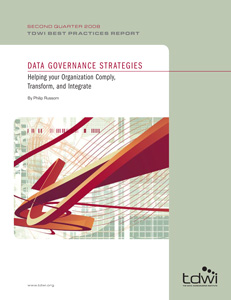
TDWI Best Practices Report | Data Governance Strategies: Helping your Organization Comply, Transform, and Integrate
April 1, 2008
Any time data crosses an organizational boundary, it should be governed, whether you’re sharing data among business units internally or publishing data to customers, partners, auditors, and regulatory bodies externally. Organizations are under renewed pressure to ensure that compliance and accountability requirements are met as the scope of data integration broadens. In response to this situation, many organizations are turning to data governance, which establishes policies and procedures for sharing data, as well as improving data’s quality, structure, and auditability.
Furthermore, a goal of some data governance programs is to enable an organization to treat data as an organizational asset. Achieving this goal demands many interim goals, most involving dramatic change. For example, data governance transforms an organization’s data, its data management technology, who owns the data, and how the organization uses data. Sweeping changes and business transformations like these need a central organizational structure such as a data governance committee or board, staffed with both business and technology people.
Given the complexity of data governance and its many influences, it’s no surprise that confusion abounds. This report from TDWI Research clears the confusion by drilling into the business initiatives, technical implementations, and cross-functional organizational structures with which data governance intersects. It also quantifies the state of data governance adoption and describes some of the technologies and vendor products that can help automate data governance. All this information is tailored to assist business and technical managers in planning and implementing a sustainable data governance program.
Provided by
Business Objects, Collaborative Consulting, DataFlux, Exeros, Informatica, SAP, SAS, Trillium